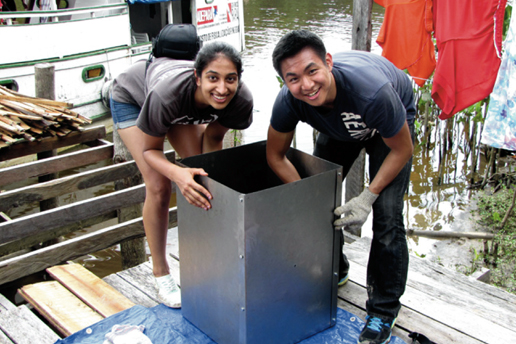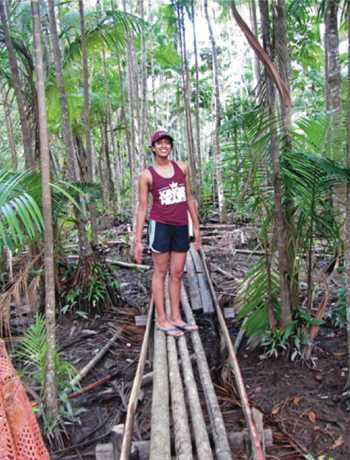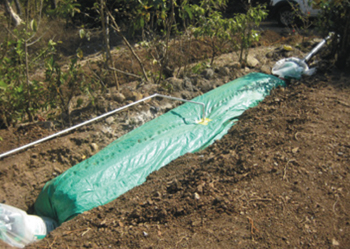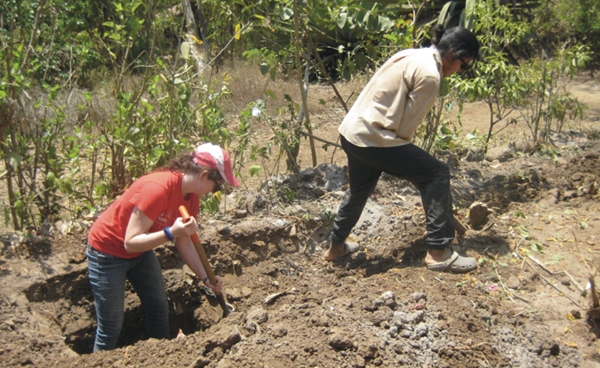
Early on in EC.711 D-Lab: Energy, MIT students are put in a dark room and asked to assemble resistors using the equivalent of candlelight. It’s a quick, experiential lesson in what many people in the developing world have to cope with every day: insufficient access to energy.
“[The students] are really blown away by how hard it is,” says instructor Libby Hsu, MEng ’10, SM ’11. And that’s exactly the point. “If you go to the developing world to talk day-to-day issues, energy is critical. People need lighting [and] fuel to cook with.”
To address such needs, Hsu and her fellow D-Lab: Energy instructor, Amit Gandhi SM ’14, work with partners in El Salvador and Brazil seeking out energy-related challenges for students to address through technology. This past spring, students explored ways to convert human waste into cooking fuel, investigated how to power an engine with fruit pits, and laid the groundwork for harnessing river power to run a generator.
“We work in one really remote Amazon community [where] … people are spending 30% of their income on [diesel fuel for] generators for electricity,” says Gandhi, a PhD candidate in mechanical engineering. “We’re looking at ways to use renewable sources.”

Maya Ramachandran ’16 stands on the raised wooden walkways that make it possible to navigate through the wet and muddy Amazonian region of Brazil. Learning about the challenging conditions common in developing countries was a key lesson of the MIT class D-Lab: Energy. Photo: Maya Ramachandran, MIT
Accessible technology
The semester-long class developed at MIT’s D-Lab (Development through Dialogue, Design, and Dissemination) begins by introducing students to a wide range of energy technologies, from bio-waste charcoal briquettes to wind turbines and solar cells. “There’s a lab every week on a different renewable energy. Students actually make solar panels; they make solar water heaters. They’re not only learning about the technology but getting shop experience,” Hsu says.
D-Lab: Energy also teaches students how to talk clearly about energy options with non-technical people, Hsu says. “We find students have taken a lot of courses but can’t necessarily talk about energy at a level others can understand.”
These skills are immediately put to use as the students are grouped into teams and assigned projects focused on aiding specific communities in Brazil and El Salvador. After conducting some initial research, the teams spend spring break abroad, talking to community members and investigating the real-world conditions their innovations are designed to address. While generating electricity was the main concern in Brazil, for example, the community in El Salvador had electricity but very limited access to running water.
“We’re very privileged here [in the United States], and to see the conditions there, it put things in perspective,” says Patricia C. Mayer SB ’14, a graduate student in chemical engineering who traveled to El Salvador.
“The way they live is completely different from anything here,” says Maya Ramachandran ’16, a double major in biology and management, who visited the Amazonian village in Brazil. “The whole community is houses on the river. … Kids would paddle on boats to other houses.”
Learning to adapt to conditions on the ground is an important lesson for students interested in working in the developing world, Gandhi says. “If you forget your pliers here [in the United States], it’s easy to get a new one. If you forget one on site, you’ve got to improvise,” he says.
Students also quickly discover that conditions in the field do not always meet expectations. For example, the team working on hydropower arrived in Brazil to discover that the local river currents were too slow to drive their turbines. The students had to adapt the project to use water from a local tilapia farm instead. Another team, working on a system to convert human waste to fuel in El Salvador, discovered that animal waste was also available—which was actually a major plus for their purposes.
“What I learned was, coming up with the technology isn’t always the hardest part—it’s more communicating with the people who are going to use it,” Mayer says.
Fossil-fuel alternatives
After their fact-finding week abroad, the students returned to MIT to finalize their designs and build prototypes of their energy-generating technologies.

MIT students helped build this bag-style biodigester to provide cooking fuel for a family in El Salvador. The biodigester generates methane gas through the anaerobic decomposition of animal and plant waste within the bag. Photo: Libby Hsu, MIT
This year’s teams built:
- A “gasifier” capable of turning charcoal made from acai pits (a local waste product in the Amazon region of Brazil) into carbon monoxide, a fuel gas with the potential to run a modified diesel engine;
- A latrine designed to work with an anaerobic waste management system called a biodigester. The system would enable a family in El Salvador to use the decomposition gases generated by the breakdown of feces and plant waste to produce methane gas as a cooking fuel; and
- A mockup of a simple hydropower turbine that could be used to generate electricity from a Brazilian tilapia farm.
“I really enjoyed this class because it was extremely hands-on,” Ramachandran says. “I learned a ton… about energy, about working with people from different cultures, about how to use tools, and how to start a project and see it through from beginning to end.”
Ramachandran says the class even changed her career aspirations. “Taking this class made me realize I really enjoy working with the developing world,” she says. “I want to stay involved with international work.”
Mayer says the class piqued her interest in pursuing an energy-related career. A chemical engineer, she says she is contemplating working with biofuels. “I learned there are many ways to go about producing energy for daily living that don’t involve fossil fuels,” she says.

Patricia C. Mayer SB ’14 works with Geovany Moreno, an employee of D-Lab partner organization ASAPROSAR, digging the trench for a biodigester in El Salvador. The biodigester will enable a family to convert animal and plant waste into methane gas, which can be substituted for propane as a cooking fuel. Photo: Libby Hsu, MIT
This article appears in the Autumn 2014 issue of Energy Futures.
Press inquiries: miteimedia@mit.edu